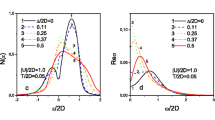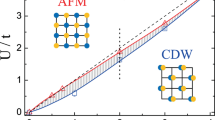Abstract:
We present an investigation of the 2D attractive Hubbard model, considered as an effective model relevant to superconductivity in strongly interacting electron systems. We use both hybrid Monte-Carlo simulations and existing hopping parameter expansions to explore the low temperature domain. The increase of the static S-wave pair correlation with decreasing temperature, which depends weakly on the band filling in the explored temperature range, is analyzed in terms of an expected Kosterlitz-Thouless superconducting transition. Using both our data and previously published results, we show that the evidence for this transition is weak: If it exists, its temperature is very low. The number of unpaired electrons remains nearly constant with temperature at fixed attractive potential strength. In contrast, the static magnetic susceptibility decreases fast with temperature, and cannot be related only to pair formation. We introduce a method by which the Padé approximants of the existing series for the susceptibility give sensible results down to rather low temperature region, as shown by comparison with our numerical data.
Similar content being viewed by others
Author information
Authors and Affiliations
Additional information
Received: 30 October 1996 / Revised: 23 October 1997 / Accepted: 29 January 1998
Rights and permissions
About this article
Cite this article
Lacaze, R., Morel, A., Petersson, B. et al. An investigation of the 2D attractive Hubbard model. Eur. Phys. J. B 2, 509–523 (1998). https://doi.org/10.1007/s100510050275
Issue Date:
DOI: https://doi.org/10.1007/s100510050275




